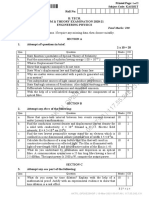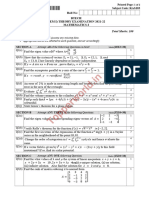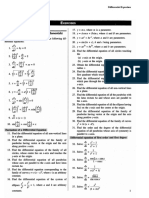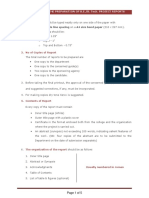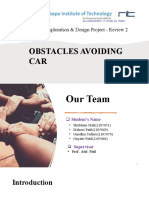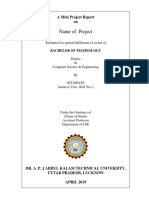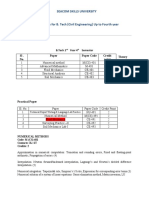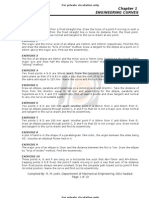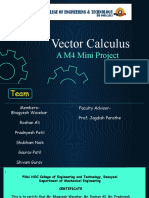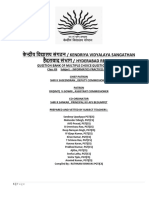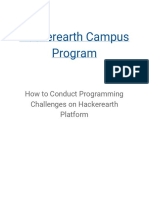0 ratings0% found this document useful (0 votes)
5K views65 pagesFE 2024 Pattern Syllabus
For fe student
Uploaded by
locouserrr1Copyright
© © All Rights Reserved
We take content rights seriously. If you suspect this is your content, claim it here.
Available Formats
Download as PDF or read online on Scribd
0 ratings0% found this document useful (0 votes)
5K views65 pagesFE 2024 Pattern Syllabus
For fe student
Uploaded by
locouserrr1Copyright
© © All Rights Reserved
We take content rights seriously. If you suspect this is your content, claim it here.
Available Formats
Download as PDF or read online on Scribd
You are on page 1/ 65
wnfettarg yet yo frantts
Savitribai Phule Pune University, Pune,
Maharashtra, India
Faculty of Science and Technology
National Education Policy (NEP)-2020 Compliant
Curriculum
First Year Engineering (2024 Pattern)
[ Common to All UG Engineering Programs}
(With effect from Academic Year 2024-25)
Scanned By Camera Scanner
Feet Year Engincerag 2104 Pater Facaty of Some and Techn
NEP 2020 Compliant Curriculum Structure
First Year Engineering (2024 Pattern)
BSC-101-BES Engineering Mathematics-1] 3 | 1
BSC-102-BES! | Basic Science | Engineering Physics /
BSC-103. Course Engineering Chemistry
esc101-27C/ | Eaciaceine | Bas Eestenis al. :
ESCIOZELE | Soemce Coue| Enieting Bas
TSC IOS MECY | Enginewing | Engineering Geaptcs 7 | | - ;
ESC-104-CVL_| Science Course | Engineering Mechanics
Engineering | Fundamentals of
Esc-ios.com | Saisie | ae 2|- 3
‘Vocational and | Manufacturing Practice
YSE-101 Skill Workshop! i
VSE-102 Enhancement | Design Thinking and idea | ~ | ~
Course Lib
“Ability
Professional 3
AEC-101 Extuacenent | ica =i 2
ece-101 Co-Curricular | Co curricular Course! | - | - 2
Spilabas for First Year of Engineering aves.
Scanned By Camera Scanner
Feet Year Engincerag 2104 Pater Facaty of Some and Techn
NEP 2020 Compliant Curriculum Structure
First Year Engineering (2024 Pattern)
Engineering Mathematics:
nH
Engineering Chemistry! |
Engineering Physics
ESC-102-ELE/ | Engineering | Basi Eletncal
Engincering/ Basic
ESC-101-ETC | Science Course| raganing
ESC-104-CVL/ | Engineering | Engineering Mechanics/
ESC-103-MEC_| Science Course | Engineering Graphics
pecasiarr | Pegam Coe [Programming and Problem | > |
Course Solving
Design Thinking and Ides
Lab / Manufacwuring I
Pracice Worksop
1Ks.151 Indian Koowiedge System | - 2
cceast [ESE co cumictarcomnent | - | - 2
CCE": Comprehensive Continuous Evaluation
Spilabas for First Year of Engineering aves,
Scanned By Camera Scanner
Program Outcomes (POs)...
Abbreviations
Guidelines for Examination Scheme
‘Course Code: BSC-101-BES Course Name: Engineering Mathematics-1_.
‘Course Code: BSC-102-BES Course Name: Engincering Physics,
‘Course Code: BSC-103-BES Course Name: Engincering Chemistry
Course Code: ESC-101-ETC Course Name: Basic Electronics Engineering
‘Course Code: ESE-102-ELE Course Name: Basic Electrical Engineering
‘Course Code: ESC-103-MEC Course Name: Engineering Graphics..
(Course Code: ESC-104-CVL Course Name: Engineering Mechanics
‘Course Code: ESC-105-COM Course Name: Fundamentals of Programming Languages
‘Course Code: VSE-101 Course Name: Manufacturing Practice Workshop...
‘Course Code: AEC-101 Course Name: Professional Communication Skills.
‘Course Code: CCC-101 Course Name Co-Curricular Course ~ 1.
‘Course Code: BSC-151-BES Course Name: Engincering Mathematics ~ I.
‘Course Code: PCC-151-ITT Course Name: Programming and Problem Sotvin
‘Course Code: IKS-151 Course Name: Indian Knowledge System,
‘Course Code: CCC-151 Course Name: Co-Cumicular Courses = We ee
‘Task Force for Curriculum Design and Development
Scanned By Camera Scanner
‘Ft Year Enginverang ~ 2104 Pattern - Faculty of Science an Tectnoy
‘The New Education Policy (NEP) 2020 has ushered a new era of change, in India’s education system to
better meet the needs of the 21st century. SPPU is committed to the effective and fruitful implementation
of NEP 2020 in its true spirits emphasizing holistic and multidisciplinary education as per the directives of
Maharashtra government. It emphasizes a multidisciplinary approach, aiming to develop critical thinking
and creativity, thereby contributing to the holistic development of individuals.
We are delighted to present the first-year engineering syllabus -2024 pattern, which has been meticulously
designed in alignment with the NEP 2020 with effect from academic year 2024-25. This curriculum aim to
provide students with a holistic approach to engineering education ensuring a strong foundation in
Mathematics and Science courses. This curriculum also includes components of vocational and skill
enhancement courses, Indian Knowledge System and Co-curricular courses to shape well-rounded
engineers who can adapt to global demands. Also, this document provides information on the credit system,
course contents, examination and evaluation scheme along with guidelines to make best use of the
curriculum designed.
The syllabus encourages experiential learning, where theoretical concepts are supported by practical
laboratory sessions. Also promotes research and innovation, encouraging students to engage in projects
from the early stages of their academic journey. I wish to thank all the Board of Studies chairpersons and
members who contributed in designing this curriculum.
We believe that this syllabus, crafted with the essence of the NEP 2020, will equip our students with the
necessary skills and knowledge to excel in their future endeavors. We look forward to embarking on this
exciting academic journey with our students.
Bw
Dean — Science and Technology
Savitribai Phule Pune University, Pune
Silas for Fest Year af
Scanned By Camera Scanner
Feet Year Engincerag 2104 Pater Facaty of Some and Techn
‘Apply the Knowledge of mathematics, science, Engineering
POL pail fundamentals, and an Engineering specialization to the solution of
complex Engineering problems.
Tdentify, formulate, review research literature, and analyze complex
PO2 | Problem analysis | Engincering problems reaching substantiated conclusions using first
principles of mathematics, natural sciences and Engineering sciences.
i ‘Design solutions for complex Engineering problems and design
— = ment of | ¥SHM Components or processes that meet the specified needs with
ia ae appropriate consideration for the public health and safety, and the
cultural, societal, and Environmental considerations
ra mao ‘Use research-based knowledge and research methods including
Pos _ | Investigatio design of experiments, analysis and interpretation of data, and
Legnraie synthesis of the information to provide valid conclusions.
Create, select, and apply appropriate techniques, resources, and
pos | Modern Toot | modem Engineering and IT tools including prediction and modelling
Usage to complex Engineering activities with an understanding of the
limitations.
“Apply reasoning informed by the contextual knowledge to assess
Pos | The Eneincer and | etal, health, safety, legal and cultural issues and the consequent
Recisty responsibilities relevant to the professional engineering practices.
Understand the i of the professional Engineering solutions in
Por Paice ad | scien and tvicouncah ‘contexts, and demonstrate the knowledge
tainabllity | of, and need for sustainable development.
con ae ‘Apply ethical principles and commit 10 professional ethics and
responsibilities and norms of Engineering practice.
poo | individual and [Function effectively as an individual, and as « member or Ieader ta
Team Work diverse eam, and in multiisciplinary settings,
‘Communicate effectively on complex Engineering activities with the
poi | Communication | Engineering community and with society a arg, such a, being able
Skills to comprehend and write effective reports and design documentation,
make effective presentations, and give and receive clear instructions.
Demonstrate knowledge and understanding of Engineering and
cor nadet ana | ™Anagement principles and apply these to one's own work, 3s
Meengneet member and leader in a team, to manage projects and in
come. multidisciplinary Environments.
ieee ‘Recognize the need for, and have the preparation and ability to engage
POI | Teaming in independent and life-long learning in the broadest context
of technologic: change.
Sylben fr ist Yen of Eagincering aes
Scanned By Camera Scanner
{et Year Enginverang ~ 2104 Pattern. Faculty of Science and Techno
AEC Ability Enhancement Course
BSC Basic Science Course
ccc Co-Curricular Courses
CCE Comprehensive Continuous Evaluation
Common Engineering Project
Course Outcome
Experiential Learning Courses
Engineering Science Course
Field Project
Indian Knowledge System
Internship
Multidisciplinary Minor
‘National Education Policy
Open Elective
On Job Training
ao
og
Program Core Course
Programme Elective Course
Program Outcomes
Practical
Project
Program Specific Outcome
Research Methodology
Theory
Tutorials
‘Value Education Course
BASPERRR SEAGER ERA ARE
Vocational and Skill Enhancement Course
Spilabas for First Year of Engineering ais
Scanned By Camera Scanner
‘Theory Examination: The theory examination shall be conducted in two different parts Comprehensive
‘Continuous Evaluation (CCE) and End-Semester Examination (ESE).
Comprehensive Continuous Evaluation (CCE) of 30 marks based on all the Units of course syllabus to
be scheduled and conducted at institute level. To design a Comprehensive Continuous Evaluation (CCE)
scheme for a theory subject of 30 marks with the specified parameters, the allocation of marks and the
structure can be detailed as follows:
‘Sr. [Parameters Marks ‘of Units
1. | Unit Test 12 Marks _[ Units 1 & Unit 2 (6 Marks/Unit)
‘Assignments / Case Study 12 Marks | Units 3 & Unit 4 (6 Marks/Unit)
4g, | Seminar Presentation / Open Book Test’ | 6 y wais
Quiz
‘Format and Implementation of Comprehensive Continuous Evaluation (CCE) =
Unit Test:
Format: Questions designed as per Bloom's Taxonomy guidelines to assess various cognitive levels
(Remember, Understand, Apply. Analyze, Evaluate, Create).
Implementation: Schedule the test after completing Units | and 2. Ensure the question paper is
balanced and covers key concepts and applications.
‘Sample Question Distribution:
© Remembering (2 Marks): Define key terms related to [Topic from Units 1 and 2].
Understanding (2 Marks): Explain the principle of [Concept] in [Context].
Applying (2 Marks): Demonstrate how [Concept] can be used in [Scenario]
Analyzing (3 Marks): Compare & contrast [Two related concepts] from Units 1 and 2.
Evaluating (3 Marks): Evaluate the effectiveness of [Theory/Model} in [Situation],
Assignments / Case Study:
‘Students should submit one assignment or one Case Study Report based on Unit 3 and one assignment or
‘one Case Study Report based on Unit 4
Format: Probiem-solving tasks, theoretical questions, practical exercises, or case studies that require in-
depth analysis and application of concepts.
Implementation: Distribute the assignments or case study after covering Units 3 and 4. Provide clear
guidelines and a rubric for evaluation.
‘Seminar Presentation:
‘Seminar Presentation Format:
‘* Oral presentation on a topic from Unit 5, followed by a Q&A session.
* Deliverables: Presentation slides, a summary report in 2 to 3 pages, and performance during the
presentation.
Implementation: Schedule the seminar presentations towards the end of the course. Provide students with
‘ample time to prepare and offer guidance on presentation skills.
Splat for First Year of
Scanned By Camera Scanner
‘Ft Year Enginverang ~ 2104 Pattern - Faculty of Science an Tectnoy
Open Book Test:
Format: Analytical and application-based questions to assess depth of understanding.
Implementation: Schedule the open book test towards the end of the course, ensuring it covers critical
aspects of Unit S.
Quiz:
Format: Quizzes can help your students practice existing knowledge while stimulating interest in learning
‘about new topic in that course. You can set your quizzes to be completed individually or in small groups.
Implementation: Online tools and software can be used create quiz. Each quiz is made up of a variety of
question types including multiple choice, missing words, true or false ete
Example Timeline for conducting CCE:
Weeks 1-4 : Cover Units 1 and 2
Week 5 : Conduct Unit Test (12 marks)
Weeks 6-8 : Cover Units 3 and 4
Week 9 : Distribute and collect Assignments / Case Study (12 marks)
Weeks 10-12 Cover Unit $
Week 13 : Conduct Seminar Presentations or Open Book Test or Quiz (6 marks)
Evaluation and Feedback:
‘Unit Test: Evaluate promptly and provide constructive feedback on strengths and areas for improvement.
Assignments / Case Study: Assess the quality of submissions based on the provided rubric. Offer
feedback to help students understand their performance.
‘Seminar Presentation: Evaluate based on content, delivery, and engagement during the Q&A session.
Provide feedback on presentation skills and comprehension of the topic.
(Open Book Test: Evaluate based on the depth of analysis and application of concepts. Provide feedback
‘on critical thinking and problem-solving skills.
By following this scheme, you can ensure a structured and comprehensive evaluation of students’
understanding and application of the course material, adhering to Bloom's Taxonomy guidelines for
cognitive skills evaluation.
End-Semester Examination (ESE) of 70 marks written theory examination based on all the unit of course
syllabus scheduled by university. Question papers will be sent by the University through QPD (Question
Paper Delivery). University will schedule and conduct ESE at the end of the semester.
Question Paper Design
Below structure is to be followed to design an End-Semester Examination (ESE) for a theory subject of
70 marks on all 5 units of the syllabus with questions set as per Bloom's Taxonomy guidelines and 14
‘marks allocated per unit:
Scanned By Camera Scanner
‘Ft Year Enginverang ~ 2104 Pattern - Faculty of Science an Tectnoy
Balanced Coverage: Ensure balanced coverage of all units with questions that assess different cognitive
levels of Bloom's Taxonomy: Remember, Understand, Apply, Analyze, Evaluate, and Create. The
‘questions should be structured to cover:
© Remembering: Basic recall of fucts and concepts.
Understanding: Explanation of ideas or concepts.
Applying: Use of information in new situations.
Analyzing: Drawing connections among ideas.
Evaluating: Justifying a decision or course of action.
Creating: Producing new or original work (if applicable).
Detailed Scheme: Unit-Wise Allocation (12 Marks per Unit): Each unit will have a combination of
questions designed to assess different cognitive levels. By following this scheme, you can ensure a
comprehensive and fair assessment of students’ understanding and application of the course material,
adhering to Bloom's Taxonomy guidelines for cognitive skills evaluation.
Term Work assessment shall be conducted for the theory courses, lab practical, VSE, IKS, AEC and CCC
assignments submitted in journal form. Term work is continuous assessment based on work done,
submission of work in the form of report journal, timely completion, attendance, and understanding.
It should be assessed by subject teacher of the institute and the final grade for a Term Work shall be
assigned based on the performance of the student and is to be submitted to the Savitribai Phule Pune
University (SPPU) at the end of the semester.
Overview:
‘Students will submit a journal documenting their practical assignments, providing a comprehensive record
of their practical work and leaming experiences throughout the course. The journal will include detailed
descriptions of the practical assignments, observations, results, reflections, and any additional relevant
materials,
Journal Components:
Practical Assignments: Each practical assignment should be clearly labelled and dated. Include the
‘assignment prompt, objectives, materials used, procedures, observations, and results. Ensure assignments
cover a variety of practical skills and techniques as outlined in the syllabus.
Reflections: Reflective entries should accompany each practical assignment, Discuss the learning
process, challenges faced, and how they were overcome. Highlight key takeaways and how the practical
assignment contributed (o overall understanding.
‘Supplementary Materials: Include any additional materials relevant to the practical assignments (¢.g.,
raw data, sketches, photographs, feedback received). Supplementary materials should be organized and
clearly linked to the corresponding assignments.
Spilabas for First Year of Engineering 10a
Scanned By Camera Scanner
‘Ft Year Enginverang ~ 2104 Pattern - Faculty of Science an Tectnoy
Evaluation Criteria:
‘© Completeness (20%): All practical assignments are included, completed, and properly labeled.
Reflective entries are present for each practical assignment.
© Quality of Work (40%): Practical assignments are completed with a high level of accuracy and
thoroughness. Demonstrates a strong understanding of practical techniques and principles. Reflective
entries provide meaningful insights into the learning process.
‘© Organization (20%): The journal is well-organized and easy to navigate. Practical assignments and.
reflections are clearly labeled and ordered chronologically. Supplementary materials are
appropriately linked and referenced.
‘* Presentation (10%): The journal is neatly presented and free of spelling and grammatical errors.
Includes a cover page with the student's name, course title, and submission date. Utilizes a consistent
format and style throughout.
‘+ Creativity and Engagement (10%): Demonstrates creativity in approach and presentation, Engages
deeply with the practical work, going beyond surface-level understanding. Shows evidence of critical
thinking and personal engagement with the assignments.
‘Submission Guidelines:
Journals should be submitted in a hound or digital format as specified by the instructor. Ensure that all
components are included and properly organized before submission. Late submissions may be subject to
penalties as per the course policy.
Example Timeline:
Weeks 1-3: Camplete and document Practical Assignments | and 2, including reflections
Weeks 4-6: Complete and document Practical Assignments 3 and 4, including reflections.
Weeks 7-9: Complete and document Practical Assignments 5 and 6, including reflections.
Week 10: Finalize and organize the journal.
Week 11: Submit the completed journal for evaluation.
Benefits:
Encourages regular and consistent engagement with practical work.
Provides a comprehensive record of student progress and learning.
Develops skills in reflection, organization, and presentation.
Allows for personalized feedback and growth opportunities.
By structuring term work evaluation through journal submissions, students can benefit from a
holistic and continuous assessment process that supports their practical skills development and
academic growth.
Conducting a two-hour tutorial session allows for more in-depth exploration and interaction compared to
shorter sessions. Here are comprehensive guidelines to effectively conduct a two-hour tutorial session for
a theory subject:
Preparation:
Review Content: Ensure a thorough understanding of the theory subject and select key topics or concepts
to cover during the session.
Spilabas for First Year of Engineering
Scanned By Camera Scanner
{re Year Enpiwerng— 2024 Pater act of Science ad Techy
Set Objectives: Define clear learning objectives that align with the course syllabus and students’ learning
needs.
Prepare Materials: Gather necessary materials such as lecture notes, slides, handouts, and any
supplementary resources or examples.
2. Structure of the Tutorial:
Introduction and Agenda Setting (0S minutes): Welcome students and outline the agenda for the
tutorial session. Clarify the learning objectives and expectations for the session.
Recap or Review (07 minutes): Recap briefly the key points from previous sessions or relevant topics.
Address any lingering questions or uncertainties from the previous material.
Presentation and Explanation (15 minutes): Present new material or delve deeper into selected topics.
Provide clear explanations using examples, diagrams, or visual aids to aid understanding. Break down
‘complex ideas into manageable parts and ensure clarity in explanations.
Interactive Discussion and Q&A (12 minutes): Engage students in discussions related to the presented
material. Encourage active participation and critical thinking through open-ended questions. Address
student queries and encourage them to ask questions for clarification,
Application and Practice (18 minutes): Assign activities or problem-solving exercises that apply the
newly learned concepts. Monitor students’ progress and provide guidance as they work through the tasks.
Facilitate peer-to-peer learning by encouraging students to discuss their approaches with peers.
‘Summary and Conclusion (05 minutes): Summarize the main points covered during the tutorial session.
Reinforce key concepts and their relevance to the broader course objectives. Prepare students for the next
steps in their learning journey related to the topic.
Feedback and Next Steps (05 minutes): Gather feedback from students on the tutorial session, including
what they found most helpful and any areas needing improvement. Provide recommendations for further
study, additional resources, or upcoming assignments related to the topic.
3. Engagement Strategies:
Active Participation: Encourage all students to actively engage in discussions and activities throughout
the session.
Use of Technology: Utilize multimedia presentations of online tools to enhance learning experiences and
engagement.
Group Activities: Incorporate group discussions or collaborative activities to promote peer learning and
interaction.
Assessment and Evaluation:
Formative Assessment: Assess student understanding through informal assessments, discussions, and
problem-solving activité
Sellars for First Vear of Eaincerine nhs
Scanned By Camera Scanner
‘Ft Year Enginverang ~ 2104 Pattern - Faculty of Science an Tectnoy
Feedback Mechanism: Provide timely feedback on students’ participation and comprehension to support
their learning progress.
. Logisties and Environment:
(Classroom Setup: Ensure a comfortable and conducive learning environment with adequate seating,
lighting, and equipment for presentations.
‘Time Management: Manage time effectively to cover all planned activities within the two-hour duration.
6. Post-Tutorial Follow-U)
Reflection: Reflect on the tutorial session to evaluate its effectiveness and identify areas for improvement
in future sessions.
‘Student Support: Offer additional office hours or online support for students who may need further
assistance with tutorial material or assignments.
By following these guidelines, you can conduct a structured and engaging two-hour tutorial session that
enhances students’ understanding and retention of theory subjects while fostering active learning and
When First Year Engineering students enter an institution, they come with diverse thoughts,
backgrounds and preparations. It is important to help them adjust to the new environment and inculcate
in them the ethos of the institution with a sense of larger purpose. Induction programme for First Year
Engineering students is introduced to familiarize them to the new environment and encourage them to
learn beyond classrooms.
Objective is to help new students adjust and feel comfortable in the new environment, inculcate in them
the ethos and culture of the institution, help them build bonds with other students and faculty members,
and expose them to a sense of larger purpose and self-exploration. Induction Program should be
preferably of 3 weeks (2 weeks at beginning first semester and 1 week at the beginning of second
semester).
In order to implement the (SIP) the following activities can be taken at college.
4) Physical Activity: - This would involve a daily routine of physical activity with games and sports.
b) Creative Arts: - Every student would choose one skill related to arts whether visual arts or
performing arts.
Spilabas for First Year of Engineering aves
Scanned By Camera Scanner
‘ret Year npimerny— 2024 Patern aca f Same al Techy
©) Mentoring and Universal Human values: -Mentoring and connecting the students with faculty
members and other students is the most important part of student induction. This can be effectively
done by forming a group of 22-24 students with a faculty mentor each. This can be implemented
through group discussion and real-life activities rather than only lecturing.
4) Familiarization with College, Department and Branch:- The incoming student should be told
about the credit, grading system and scheme of the examination. They should be explained how the
study in College differs from the study in school. They should be taken on College tour and shown
important facilities such as library, canteen, gymkhana etc. They should be shown their own
department.
©) Literary Activity:- Literary Activity would compass reading book, writing a summary, debating,
enacting a play etc.
f) Proficiency modules: - The modules can be designed to overcome some critical lacunas that
students might have like English Speaking, Computer familiarity etc.
g) Lectures by Eminent People: - The lectures of Eminent people be organized to expose the students
to social activity and public life.
h) Visit to local Area:- A couple of visits to the landmarks of the city or a hospital are orphanage
‘could be organized.
i) Extracurricular activities in College:- The new students should be introduced tw the
‘extracurricular activities at the College.
j) Feedback and Report on the program:-Students should be asked to give their mid program
Feedback wherein each group of 22-24 students should be asked to prepare a single report on their
‘experience of the program.
‘These are summarized guidelines to be given to the student inducing induction programme (SIP). Please
refer SIP Manual published by AICTE for detail guidelines at htips:/www.aicte-india.org/content/student-
induction-program-detailed-suide,
Spilabas for First Year of Engineering wales
Scanned By Camera Scanner
{et Year Enginverang ~ 2104 Pattern. Faculty of Science and Techno
waifedtarg wa yo fran
Savitribai Phule Pune University
Faculty of Science and Technology
National Education Policy (NEP) Compliant Curriculum
First Year Engineering (2024 Pattern)
Spilabas for First Year of Engineering sles
Scanned By Camera Scanner
[Prerequisite Courses, If any:
© Differentiation, Integration, Maxima and Minima, Matrices and Determinants.
[Course Objectives:
[To familiarize the students with concepts and techniques in Calculus, Fourier series and Linear Algebra.
[The aim is to equip them with the techniques to understand advanced level mathematics and its
lapplications that would enhance analytical thinking power, useful in their disciplines.
[Course Outeomes:
[After successful completion of the course, learner will be able to:
[CO1: Apply mean value theorems and its generalizations leading to Taylors and Maclaurin’s series
luseful in the analysis of engineering problems. Determine the Fourier series representation and harmonic
lanalysis of periodic functions in engineering applications.
[CO2: Evaluate derivative functions of several variables that are essential in various engineering
[problems.
|CO3: Apply the concept of Jacobian to find partial derivatives of implicit function and functional
ldependence. Use of partial derivatives in estimating errors & approximations and finding extreme values
lof the function.
|CO4: Apply the essential tool of matrices and linear algebra in a comprehensive manner for analysis of
lsystem of linear equations, Linear dependence & Independence, finding linear and orthogonal
lransformations.
|COS: Determine Eigen values & Eigen vectors. Use ito diagonalize matrix and to reduce quadratic
{form to canonical form, applicable to engineering problems.
‘Course Contents
Unit T Single Variable Calculus (08 Hours)
[Rolle’s Theorem, Mean Value Theorems, Taylor's and Maclaurin’s Series, Indetemninate Forms and
IL’ Hospital's Rule.
[Fourier series: Full range and Half rage Fourier series, Harmonic analysis, Applications to problems in
[Engineering
Unit If Multivariable Caleulus ~ Partial Differentiation (08 Hours)
[introduction to Functions of several variables, Limit, Continuity and Partial Derivatives. Euler's Theorem
lon Homogeneous functions, Partial derivative of Composite Function, Total Derivative and Change of
‘Syllabus for First Year of Engineering eles
Scanned By Camera Scanner
You might also like
- 3300004engineering Physics - Group-1 - PDFNo ratings yet3300004engineering Physics - Group-1 - PDF6 pages
- Engineering Mathematics I (15mat11) - Notes PDFNo ratings yetEngineering Mathematics I (15mat11) - Notes PDF165 pages
- Levet I: (Problems Based On Fundamentals)No ratings yetLevet I: (Problems Based On Fundamentals)55 pages
- Unit-1 Electromagnetic Theory: Phy109 - Engineering PhysicsNo ratings yetUnit-1 Electromagnetic Theory: Phy109 - Engineering Physics54 pages
- Engineering Chemistry by Jain and Jain Google BooksNo ratings yetEngineering Chemistry by Jain and Jain Google Books10 pages
- Electronic Circuits Fundamentals and Applications 3rd Edition Mike Tooley Online Version100% (1)Electronic Circuits Fundamentals and Applications 3rd Edition Mike Tooley Online Version149 pages
- Eee I Engineering Mathematics I (15mat11) NotesNo ratings yetEee I Engineering Mathematics I (15mat11) Notes165 pages
- Seacom Skills University: B.Tech 2 Year 4 Semester Theory Paper Sl. No. Paper Paper Code Credit PointNo ratings yetSeacom Skills University: B.Tech 2 Year 4 Semester Theory Paper Sl. No. Paper Paper Code Credit Point11 pages
- N S P D E: Umerical Olution OF Artial Ifferential Quations100% (1)N S P D E: Umerical Olution OF Artial Ifferential Quations55 pages
- Chapter Wise Study Notes BSC-I (311305) - AY - 202526No ratings yetChapter Wise Study Notes BSC-I (311305) - AY - 20252669 pages
- Advanced Engineering Mathematics 10th Edition Erwin Kreyszig PDF AvailableNo ratings yetAdvanced Engineering Mathematics 10th Edition Erwin Kreyszig PDF Available71 pages
- (Final) HSC-Maths Board Question Paper With SolutionsNo ratings yet(Final) HSC-Maths Board Question Paper With Solutions11 pages
- Guide How To Host A Programming Contest On Hacker EarthNo ratings yetGuide How To Host A Programming Contest On Hacker Earth18 pages
- Graphics Imp Questions 2024 Pattern by Imp Solution HubNo ratings yetGraphics Imp Questions 2024 Pattern by Imp Solution Hub4 pages
- Question Bank of Engineering Chemistry-1No ratings yetQuestion Bank of Engineering Chemistry-1138 pages
- SPPU FE 2024 (2024-2025) Pattern SyllabusNo ratings yetSPPU FE 2024 (2024-2025) Pattern Syllabus66 pages





